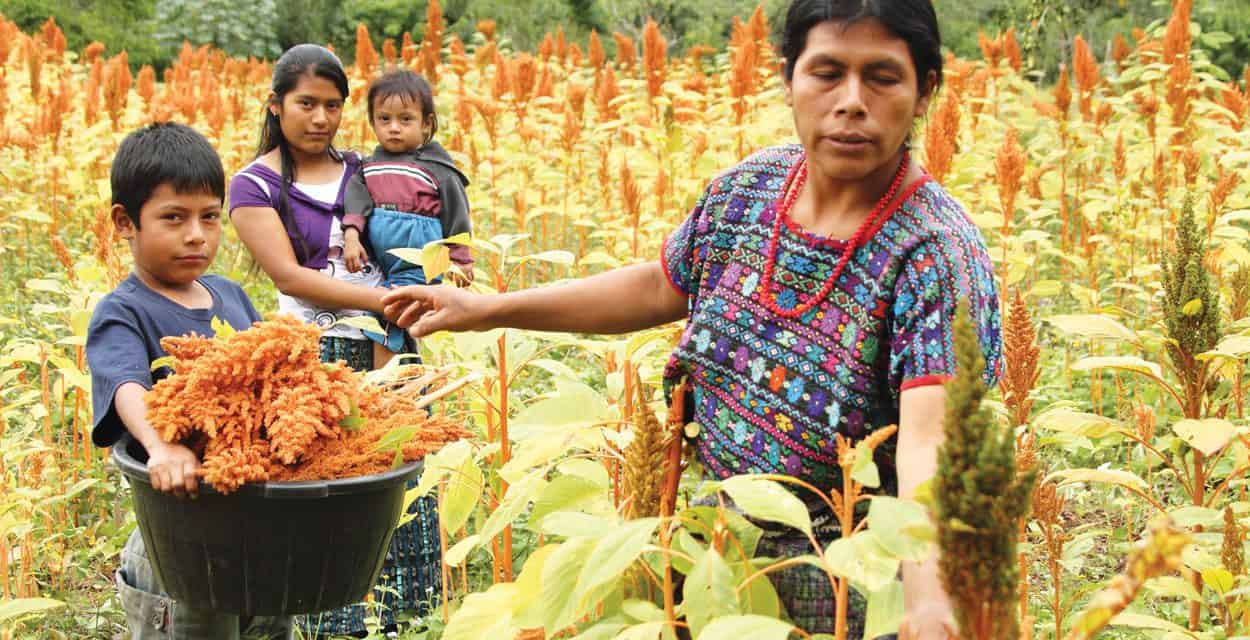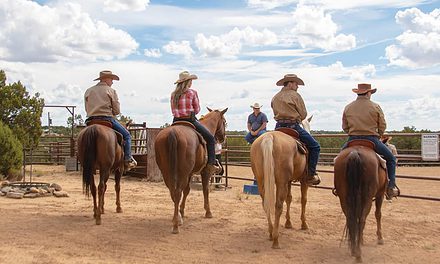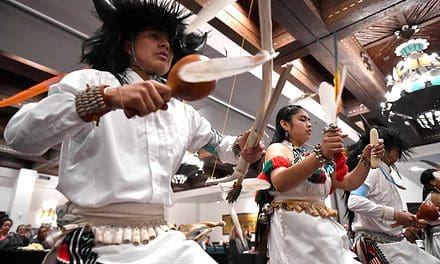The Amaranth Seed is a Grain of Hope
By Ungelbah Dávila-Shivers

Amaranth harvest in Guatemala. Each year some of these seeds make their way to New Mexico as part of The Garden’s Edge’s Seed Travels cultural exchanges. Photo by JC Lemus.
In a few small gardens around New Mexico, amaranth is being rediscovered on ancestral Tewa and Tiwa land. Amaranth is part of a burgeoning movement toward food sovereignty, decolonization, and a resurgence around reclaiming traditional diets. Incredibly adaptable to climate change, herbicides, and urbanization, amaranth is dense in protein, fiber, and vitamins. This forgotten superfood of the Americas could gain greater significance to food systems in the Southwest and beyond in the coming decades.
From the Aztec Empire to the Ancestral Puebloans, amaranth has been a food staple, medicine, and sacred plant for Indigenous peoples longer than it has been disregarded as a weed or sidelined as an ornamental flower by mainstream agriculture. As the original stewards of the continent, Indigenous communities are at the forefront of reintroducing amaranth into mainstream consciousness, starting at the grassroots level. For a growing number of New Mexican farmers, activists, students, and food sovereignty organizations, amaranth is a symbol of survival: a tiny seed that played a key role in sustaining our bodies, minds, and spirits for thousands of years and may now be a key to ensuring our future.
“We’re relearning some of the practices and plants that we’ve lost, and reintroducing ourselves back to the sacred food that we’ve neglected,” says Reyna Banteah (Zuni) of Chispas Farm. “The food sovereignty piece, of being able to feed ourselves and feed each other, makes amaranth more than just a weed. ”
In the early aughts, Sarah Montgomery of The Garden’s Edge in Albuquerque brought a group of Mayan farmers from the Qachuu Aloom Asociación Madre Tierra (Mother Earth Association) in Guatemala to present about amaranth at the Indigenous Sustainable Communities Design Course offered by the Traditional Native American Farmers Association. Here, a relationship was rekindled between Indigenous communities in New Mexico and those to the south.
This tradition of trade existed long before borders and fences, and it is being restored now through the shared cultivation of Elena’s Red Amaranth, Juana’s Orange Amaranth, and Aurelia’s Green Amaranth—three varieties of Amaranthus cruentus named after women from Qachuu Aloom—alongside the rediscovery of our own native varieties. The Mayan plants produce a white seed that is slightly larger than our New Mexican varieties of Palmer amaranth, which produce a small black seed that was traditionally eaten raw or ground and mixed with cornmeal, and our Hopi Red Dye that also produces a small, edible black seed. As the name suggests, Hopi Red Dye is highly pigmented and is often used for dye—for example, to color piki bread, a traditional amaranth bread of the Hopi and Zuni.
“Amaranth is this amazing plant that helps rekindle relationships with people, and it’s also opened the door to saving and sharing other seeds,” says Montgomery, who has seen grandmothers in her workshop cry because they remembered the plant from their childhood. She calls it a happy plant and says music and celebration will often happen around the amaranth workshops. “It brings healing to people—physical healing, because it’s such a healthy plant, but emotional and spiritual healing, too.”
Beata Tsosie-Peña (Tewa), coordinator of the Environmental Health and Justice Program at Tewa Women United (TWU), was among those to first develop a kinship with Qachuu Aloom’s amaranth ambassadors. Today Juana’s, Elena’s, and Aurelia’s amaranth varieties are staples in the Española Healing Foods Oasis, a community garden project that Tsosie-Peña created in 2016 through TWU. It’s her belief that amaranth is the fourth sister to corn, beans, and squash, a sister that became forgotten somewhere along the way because it grows naturally among crops, popping up anywhere ground is disturbed.
“Some of these plants preceded humans,” she says. “We coevolved with foods like corn and amaranth, so we have these living relationships. I wonder how many people look at amaranth as a teacher or an elder to learn from?”
While primarily building a seed bank, Healing Foods Oasis has also been able to share some of its amaranth grains with the community. Because the grain is so high in protein, a little goes a long way and a tablespoon or two can be added to almost anything. In Guatemala, where amaranth is being used to fight child malnutrition, the seeds are popped and mixed with honey to create a highly nutritious alegria bar. Also a doula and breastfeeding coach, Tsosie-Peña cites amaranth as a great nutritional supplement for pregnant and postpartum women.
Amaranth is a hard grain, and many prefer to boil it like rice and add it to a myriad of meals, from tuna patties to smoothies. To pop the seeds, you don’t want steam, so there’s no need to use a lid on your pot, just a few minutes over the heat. The grains can also be soaked and then boiled into a porridge, or ground into flour for baking. Cloud Cliff Bakery in Santa Fe has become known for its amaranth loaf, which Willem Malten developed in 1983. Malten has long advocated for amaranth, stating that words like “pigweed” and “superweed” are a calculated attempt by Monsanto to create an ideological framing that vilifies the plant. But amaranth is getting the last laugh through its continued ability to evolve in ways that make it resistant to herbicides.
“There’s this lesson that keeps unfolding,” says Montgomery. “Amaranth is Monsanto’s biggest enemy, with ‘pigweed’ growing in their corn crops, and it’s developed a resistance to Roundup. But I think its original role was to always be in the fields along with the corn. You would weed it, but the weeds had all this nutrition. Before your corn was ready you had all these other foods to harvest, but when chemical agriculture came in and they started using herbicides, all that went away.”

In Santa Clara Pueblo, the Flowering Tree Permaculture Institute has been experimenting with food decolonization since 1987. In 2013, board president Roxanne Swentzell (Tewa) started the Pueblo Food Experience project, where for three months she and fourteen volunteers of Pueblo descent ate only what their ancestors would have eaten before contact with Europeans. Her goal was to see what would happen if they ate the foods that they had evolved alongside for over twenty generations. What they discovered was that returning to a precolonial diet resulted in weight loss, blood sugar control, lowered cholesterol, and even a drastic improvement in one volunteer’s lupus symptoms. In other words, the dietary change mitigated many of the diseases Native people have been dying from during the last century.
Along with her peers, bringing amaranth into the kitchen is an end goal for Tsosie-Peña, who hopes it will play a larger role in restoring traditional food practices within Native communities, and eventually the world. Tsosie-Peña offers amaranth workshops through TWU, where she teaches everything from sowing the seeds to winnowing the grain. In 2019, she introduced the history and cultivation of amaranth to the Institute of American Indian Arts (IAIA) in Santa Fe, where students began their own efforts to decolonize this ancient seed in their land-grant garden. There aren’t machines available to separate the grain from the flower, so a successful harvest requires a communal effort by people who have learned the winnowing techniques developed thousands of years ago. This harvesting knowledge arrived at IAIA from Qachuu Aloom, whose Mayan farmers were able to visit as part of Garden’s Edge’s Seed Travels program.
“Native people have shared plants and food since the beginning of time,” says Teresa Kaulaity Quintana (Kiowa), the IAIA Land-Grant program associate and gardener. “Plants like amaranth were given to us by the Creator to keep us healthy and resilient. Our ability to share with each other traditional ways of growing our sacred food and medicine, how to harvest it, and how to use those plants is essential to our well-being and healing of generational trauma, which includes forced diet changes.”
As climate change continues to be an escalating concern all over the world, resulting in extreme droughts here in the Southwest in the last decade, amaranth is popping up on the radar more and more due to its ability to adapt quickly to new environments. In the South Valley of Albuquerque, Banteah and Casey Holland have begun cultivating amaranth at Chispas Farm. Last year they were able to harvest twenty pounds of amaranth grain from a handful of Guatemalan-variety plants, which grew to be six feet tall. They began experimenting with amaranth two seasons ago, and Holland says it has been very well received by their community supported agriculture (CSA) customers. They wanted to reintroduce the food into people’s diets and diversify their offerings.
“The amaranth became a conversation starter for folks visiting Chispas Farm,” says Holland. “They wanted to know what that gorgeous plant was, and that opened the conversation for the history of it and how vital it is to our environment and our climate. It makes sense from a market-farm perspective to start integrating some of these crops into our rotation that help build a more resilient system overall.”
Amaranth seeds have been found at Chaco Canyon as well as the Coxcatlan Cave in the Tehuacán Valley of Mexico. According to the George Mateljan Foundation, amaranth has twice as much of the amino acid lysine and twice as much or more iron, magnesium, and calcium as wheat, but upon the arrival of Spanish colonists in Mexico and Central America, amaranth cultivation was vilified—and perhaps violently punished—for its associations with Indigenous ceremonial practices. This forced restriction led to a colonial eradication of the crop that had significant impact: not only was amaranth a dietary staple in Indigenous communities, but amaranth grains and dye were also used in ceremony and by warriors in their preparation for battle.

In the Pueblos of New Mexico, the Spanish preferred wheat and so it quickly replaced amaranth in their gardens, as well as their diet. According to Tsosie-Peña, this is when the iconic outdoor bread ovens were introduced into Pueblo communities. With the Industrial Revolution, railroads came through and, again, their best crops were exported out of the community. Today, many tribal communities have become food deserts reliant in part on government food commodity programs.
“We were forced to give a tithe to the mission of our best crops,” says Tsosie-Peña. “I learned from historian Porter Swentzell that they would also weaponize our matrilineal symbols by requiring the tithe to be the length of a woman’s manta full of corn and other crops, or the family would be severely punished. If you look at the whole history of the colonization of our food systems, we are still recovering from their dismantling and trying to reclaim them fully.”
As with Indigenous languages and stories, dependence on amaranth was replaced by a foreign culture, but never completely lost. And the plant itself never went away; rather, she continues to grow wherever the ground is broken, nurturing birds, bees, and other vital pollinators with her flowers before seeding herself on the wind and in the fetlocks and fur of wild animals, waiting for her time to come back around. And as she has waited to be remembered, she has continued to evolve with a rapidly changing earth, resisting herbicides and adapting to drought and urban development, so that she will be ready to flourish when the time is right.
The name amaranth comes from the Greek words anthos (flower) and amarantos, which describes something that does not wither or fade, but she is recognized all across Turtle Island in a multitude of Indigenous languages, both written and unwritten. In Zuni the word for amaranth is kushutsi kyawe; in Hopi it is komo; in Tewa it is Su; in Diné it is tłʼohdeeí hoshí; in Tohono O’odham it is cuhukia kai; and it is tsez in the Achi dialect of the Mayan language. In communities from Española to East LA, amaranth has become a source of pride and celebration as it connects us to one another and to the ancestors who first inhabited this continent. It provides a solution to issues of food sovereignty, a means of survival in a changing environment, a cure to illness, and a path to healthy children and babies.
“I see amaranth becoming really widespread nationwide in Indigenous communities because of its nutritional value, and because as climate change impacts increase, we’ll fall back on these foods,” says Tsosie-Peña. “As we transition from this globalized dependence on food sources outside of our local regions and start returning to localized food systems, which is a very natural transition with climate change, amaranth is there offering a solution to feeding the world, but we haven’t been listening.”
Edible celebrates New Mexico's food culture, season by season. We believe that knowing where our food comes from is a powerful thing. With our high-quality, aesthetically pleasing and informative publication, we inspire readers to support and celebrate the growers, producers, chefs, beverage and food artisans, and other food professionals in our community.
















